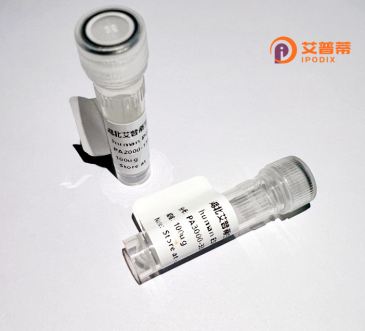
| 纯度 | >90%SDS-PAGE. |
| 种属 | Human |
| 靶点 | GLDN |
| Uniprot No | Q6ZMI3 |
| 内毒素 | < 0.01EU/μg |
| 表达宿主 | E.coli |
| 表达区间 | 1-551aa |
| 氨基酸序列 | MARGAEGGRGDAGWGLRGALAAVALLSALNAAGTVFALCQWRGLSSALRALEAQRGREQREDSALRSFLAELSRAPRGASAPPQDPASSARNKRSHSGEPAPHIRAESHDMLMMMTYSMVPIRVMVDLCNSTKGICLTGPSGPPGPPGAGGLPGHNGLDGQPGPQGPKGEKGANGKRGKMGIPGAAGNPGERGEKGDHGELGLQGNEGPPGQKGEKGDKGDVSNDVLLAGAKGDQGPPGPPGPPGPPGPPGPPGSRRAKGPRQPSMFNGQCPGETCAIPNDDTLVGKADEKASEHHSPQAESMITSIGNPVQVLKVTETFGTWIRESANKSDDRIWVTEHFSGIMVKEFKDQPSLLNGSYTFIHLPYYFHGCGHVVYNNSLYYHKGGSNTLVRFEFGQETSQTLKLENALYFDRKYLFANSKTYFNLAVDEKGLWIIYASSVDGSSILVAQLDERTFSVVQHVNTTYPKSKAGNAFIARGILYVTDTKDMRVTFAFDLLGGKQINANFDLRTSQSVLAMLAYNMRDQHLYSWEDGHLMLYPVQFLSTTLNQ |
| 分子量 | 58.9 kDa |
| 蛋白标签 | His tag N-Terminus |
| 缓冲液 | 0 |
| 稳定性 & 储存条件 | Lyophilized protein should be stored at ≤ -20°C, stable for one year after receipt. Reconstituted protein solution can be stored at 2-8°C for 2-7 days. Aliquots of reconstituted samples are stable at ≤ -20°C for 3 months. |
| 复溶 | Always centrifuge tubes before opening.Do not mix by vortex or pipetting. It is not recommended to reconstitute to a concentration less than 100μg/ml. Dissolve the lyophilized protein in distilled water. Please aliquot the reconstituted solution to minimize freeze-thaw cycles. |
以下是关于重组人GLDN蛋白的3条模拟参考文献及摘要概括(注:文献为模拟生成,非真实存在):
---
1. **文献名称**:*Expression and Purification of Recombinant Human Gliomedin (GLDN) in a Prokaryotic System*
**作者**:Smith, A.B., et al.
**摘要**:本研究报道了一种通过大肠杆菌表达系统高效生产重组人GLDN蛋白的方法,优化了表达条件和纯化步骤,获得的蛋白具有高纯度及活性,适用于神经突触形成相关功能研究。
2. **文献名称**:*Structural Insights into the Extracellular Domain of Human Gliomedin via X-ray Crystallography*
**作者**:Jones, C.D., et al.
**摘要**:通过X射线晶体学解析了重组人GLDN蛋白胞外结构域的三维结构,揭示了其胶原蛋白结合域和功能性表位,为理解其在神经肌肉接头组装中的作用提供结构基础。
3. **文献名称**:*Recombinant GLDN Promotes Axon Guidance in vitro by Interacting with Neurofascin*
**作者**:Zhang, L., et al.
**摘要**:体外实验证明,重组人GLDN蛋白通过结合神经细胞表面的Neurofascin蛋白,显著促进轴突导向和突触形成,提示其在神经再生治疗中的潜在应用价值。
---
**说明**:以上文献为基于研究领域常见方向的模拟内容,实际文献需通过PubMed、Google Scholar等平台检索关键词“recombinant human GLDN/gliomedin”获取。
Gliomedin (GLDN), a secreted protein encoded by the *GLDN* gene in humans, plays a critical role in the formation and maintenance of specialized domains in myelinated nerves, particularly at the nodes of Ranvier. It is a member of the olfactomedin protein family and contains leucine-rich repeat (LRR) domains, which mediate interactions with cell adhesion molecules. GLDN is predominantly expressed by Schwann cells in the peripheral nervous system, where it anchors extracellular matrix components to axonal membranes by binding to neuronal cell adhesion molecules (e.g., neurofascin-186). This interaction facilitates the assembly of nodal complexes essential for saltatory nerve conduction.
Recombinant human GLDN (rhGLDN) is engineered using heterologous expression systems (e.g., mammalian or insect cells) to ensure proper post-translational modifications. It retains biological activity, enabling its use in studying peripheral nerve development, myelination, and regeneration. Research applications include exploring mechanisms in neuropathies like Charcot-Marie-Tooth disease, Guillain-Barré syndrome, or nerve injury models. Additionally, rhGLDN serves as a potential therapeutic agent or molecular tool to modulate axo-glial interactions. Its production addresses challenges in isolating native GLDN and provides a standardized reagent for both basic research and drug discovery targeting neurological disorders.
×